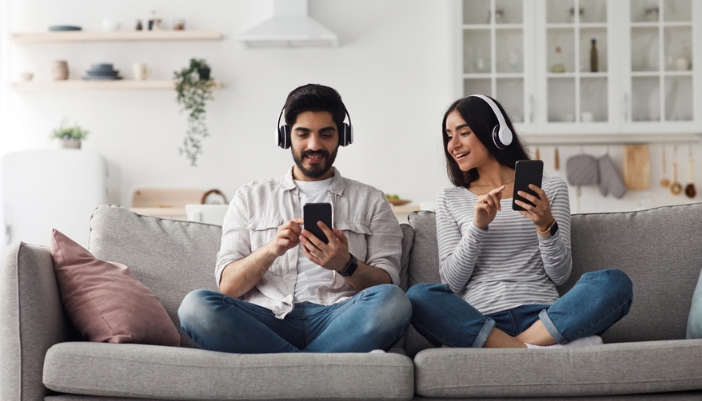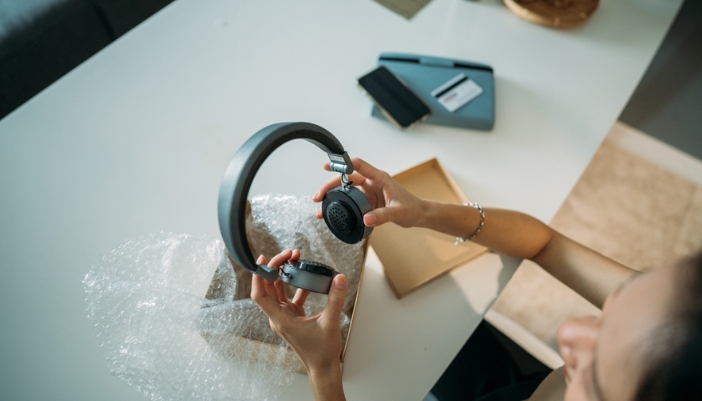You wouldn't buy a car without taking it for a test drive, right? So why do so many people grab the first pair of headphones that look cool without checking if they sound good—or worse, feel like a medieval torture device after 20 minutes?
Here's the thing: sound quality isn't just about cranking up the volume, and comfort isn't something you figure out after you buy. Testing headphones the right way makes all the difference between an investment you love and an expensive regret.
Not sure where to start? That's where we come in. Our experts at Jones Appliance and TV know all the tricks to finding headphones that deliver great sound, all-day comfort, and a fit that won't drive you crazy.

The Right Way to Test Sound Quality
Let's be honest—most people test headphones by blasting their favorite song and deciding in five seconds whether it "sounds good." But to avoid buyer's remorse, there's a smarter way to check for sound quality.
- Clarity & Detail: Can you hear individual instruments, or does everything blend into a muddy mess? Try songs with acoustic instruments or soft vocals to test this.
- Balanced Sound: Do the bass, mids, and highs work together, or does one overpower the rest? Extreme bass might sound cool at first, but it can drown out essential details.
- Distortion at High Volume: Turn it up—just not too much! Do the sounds stay clean, or do they crackle and distort?
- Soundstage & Depth: Close your eyes. Does the music feel like it is coming from all around you, or is it stuck inside your head? A good pair of headphones should create a sense of space.
- Wired vs. Wireless: If testing Bluetooth headphones, pay attention to any lag or compression. Wired headphones usually sound cleaner, but modern wireless tech has come a long way!
Comfort Matters More Than You Think
You ever buy a pair of shoes that looked great but felt like torture after an hour? Headphones can be the same way. Sound quality is important, but if they squeeze your head like a vice or make your ears sweat, you won't want to wear them for long. Comfort isn't just a luxury—it's the difference between a great listening experience and a constant headache.
There are a few things to check for before purchasing:
- Weight & Padding: Heavy headphones can feel great at first, but after an hour, they might turn into a neck workout. Look for soft, breathable padding that doesn't trap heat.
- Ear Cup Size & Shape: Over-ear headphones should fully surround your ears, not press against them. On-ear models rest on the ears, so test them for pressure points.
- Headband Pressure: If you feel like your skull is in a clamp, the band is too tight. A little snugness is good for stability, but discomfort isn't worth it.
- In-Ear Fit: Earbuds should seal well without forcing them in. Try different ear tip sizes if they keep slipping out or feel painful.
- Long-Term Wear Test: Keep them on for at least 10–15 minutes. What feels fine at first might start to irritate over time.

Noise Cancellation vs. Isolation—Know the Difference
Ever cranked up your music to drown out background noise? That's a one-way ticket to ear fatigue (and possibly annoying everyone around you). The good news? The right headphones can block out distractions without blasting your eardrums. But not all noise-blocking tech works the same way.
Here's how you can easily test both types:
- Active Noise Cancellation (ANC): This tech uses tiny microphones to cancel out external noise. Test it by standing near something loud—like an air conditioner or a busy street—and see how much sound disappears.
- Passive Noise Isolation: Instead of fancy tech, this relies on a snug fit to physically block outside noise. Over-ear headphones with thick ear pads or in-ear models with good seals do this best.
- The "No Music" Test: Turn on ANC without playing music. Do you feel pressure in your ears? Some people find intense ANC uncomfortable over time.
- Speech Blocking: ANC is great for steady noises like engine hums, but not all models handle voices well. Try talking to someone or standing near chatter—can you still hear them?
- Transparency Mode: Some headphones let outside sounds in when needed (great for staying aware of your surroundings). Test how natural voices sound in this mode.
Pro Tip:
ANC can slightly change sound quality. Try the same song with ANC on and off—if it affects the audio too much, you might prefer good noise isolation instead.

The Fit Test: Don't Skip This Step
Bad-fitting headphones are like bad-fitting jeans—uncomfortable, frustrating, and constantly needing adjustment. A poor fit can mess with sound quality, cause ear fatigue, and even make noise isolation useless. Before you buy, make sure they actually stay put.
- The Shake Test: Move your head side to side, look up and down—do they stay in place? They're not a good fit if they slip or feel like they might fly off.
- Seal Check (For Earbuds): A proper seal is key to good bass and noise isolation. If your music sounds thin or hollow, try different ear tip sizes.
- Pressure Points: Do they pinch anywhere? If you feel discomfort within minutes, it will only worsen over time.
- Glasses & Earrings Friendly? If you wear either, make sure they don't dig into your skin or press too hard.
- Sweat & Movement Test: Planning to use them at the gym? Walk around, jog in place—do they shift or feel secure?
Connectivity & Controls: Do They Work for You?
Ever tried to pause a song, only to hit the wrong button and skip tracks instead? Or worse—had your Bluetooth connection drop right when your favorite part was coming up? A pair of headphones might sound amazing, but if the controls are frustrating or the connection is spotty, they'll drive you insane.
We’ve put together a quick list of things to check:
- Bluetooth Range & Stability: Walk a few steps away from your phone—does the connection hold? Walls and interference can mess with weak Bluetooth signals.
- Audio Lag Test: Watching videos or gaming? Play something with dialogue and check if the sound syncs with the visuals. Some wireless headphones have a noticeable delay.
- Multipoint Connection: If you switch between devices (like a phone and laptop), see how easily the headphones connect to both.
- Built-in Controls: Try adjusting volume, skipping tracks, and answering calls—are the buttons or touch controls easy to use, or do they feel awkward?
- Mic Test for Calls: Make a quick call or record yourself talking. Does your voice sound clear or like you're underwater?

Wrap Your Ears Around the Right Choice
Great headphones aren't just about specs and brand names—they're about your experience. The right pair should disappear onto your head, making every song, movie, or call sound effortless and immersive.
Still on the fence? Our experts are here to answer questions, walk you through the options, and help you find a pair that checks all the boxes. Try them out, ask away, and shop our selection—we'll make sure you walk out with headphones that belong in your life.